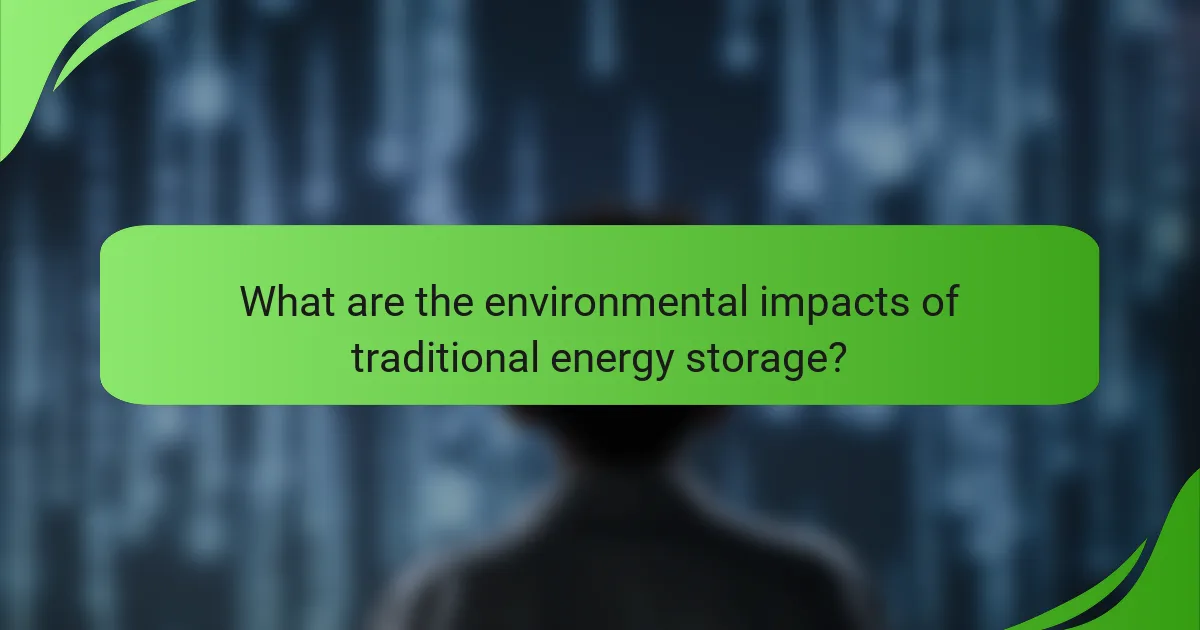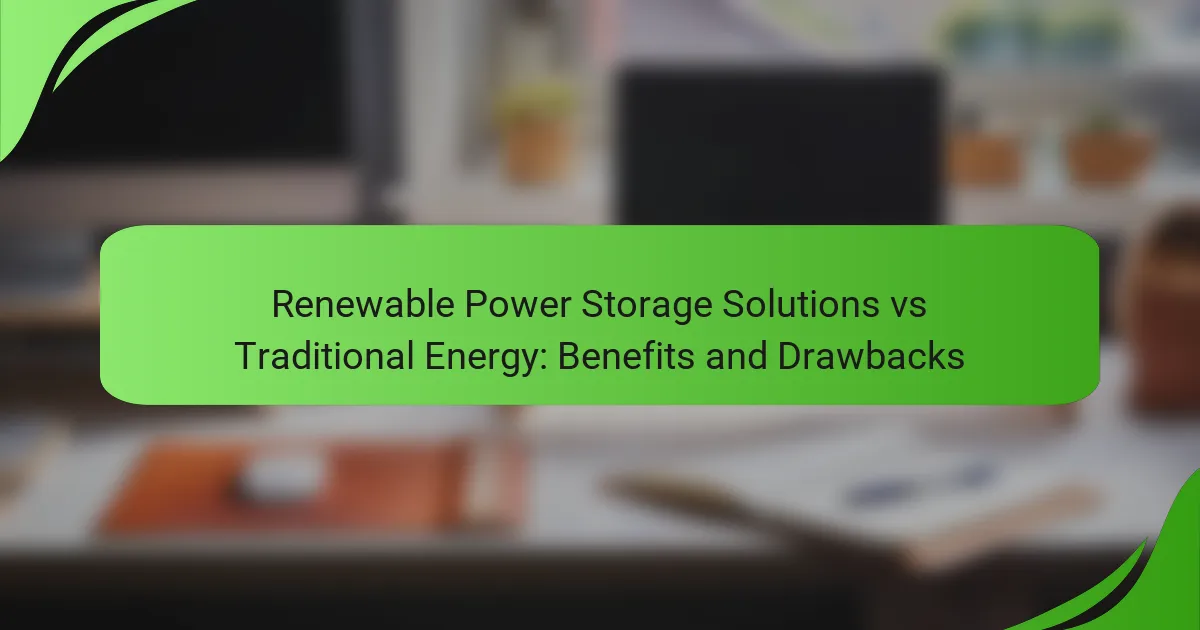The transition from traditional energy systems to renewable power storage solutions presents a complex landscape of benefits and drawbacks. While renewable storage enhances efficiency and sustainability by ensuring a consistent energy supply, it also faces challenges like high initial costs and limited lifespan. In contrast, traditional energy storage methods, though reliable, may not align with the growing demand for cleaner energy alternatives.

What are the benefits of renewable power storage solutions?
Renewable power storage solutions offer significant advantages over traditional energy systems, primarily by enhancing efficiency and sustainability. They enable the capture and storage of energy generated from renewable sources, ensuring a steady supply even when production fluctuates.
Environmental sustainability
Renewable power storage solutions contribute to environmental sustainability by reducing reliance on fossil fuels. They help lower greenhouse gas emissions and minimize air pollution, which is crucial in combating climate change.
For instance, battery storage systems can store excess solar energy generated during sunny days for use at night, thus maximizing the use of clean energy. This shift not only benefits the environment but also promotes a healthier ecosystem.
Energy independence
Utilizing renewable power storage solutions enhances energy independence by decreasing reliance on imported fuels. Countries can harness their natural resources, such as wind and solar, to meet their energy needs.
This independence can lead to more stable energy prices and reduced vulnerability to global market fluctuations. For example, nations investing in local renewable storage technologies can better manage their energy supply and demand without external pressures.
Cost savings over time
While the initial investment in renewable power storage solutions may be higher than traditional energy systems, they often lead to significant cost savings over time. Lower operational costs and reduced energy bills can offset the upfront expenses.
For example, homeowners with solar panels and battery storage can save on electricity costs by using stored energy during peak pricing hours. Additionally, government incentives and subsidies can further enhance the financial viability of these systems.
Scalability and flexibility
Renewable power storage solutions are highly scalable and flexible, making them suitable for a variety of applications, from residential to industrial. Systems can be expanded or modified based on energy needs and technological advancements.
This adaptability allows users to start with a smaller system and gradually increase capacity as demand grows or as budgets allow. For instance, businesses can implement battery storage solutions that align with their growth strategies, ensuring they can meet future energy requirements efficiently.

What are the drawbacks of renewable power storage solutions?
Renewable power storage solutions, while essential for managing energy supply, come with several drawbacks that can impact their effectiveness and adoption. Key issues include high initial costs, limited battery lifespan, and geographic constraints that can hinder their implementation.
High initial investment
The upfront costs of renewable power storage systems, such as batteries and associated infrastructure, can be significant. For instance, installing a solar battery system can range from several thousand to tens of thousands of dollars, depending on capacity and technology. This high initial investment can deter individuals and businesses from adopting these solutions, despite potential long-term savings.
Financing options, such as loans or incentives, may help mitigate these costs, but they often require careful consideration of the total cost of ownership over time. Evaluating the return on investment is crucial for making informed decisions about renewable energy storage.
Limited lifespan of batteries
Batteries used in renewable energy storage typically have a limited lifespan, often ranging from 5 to 15 years, depending on the technology and usage patterns. This limited durability means that users may need to replace batteries multiple times over the lifespan of their renewable energy systems, adding to overall costs.
Understanding the specific lifespan and warranty conditions of different battery types can help users plan for future expenses. Regular maintenance and monitoring can also extend battery life, but this requires additional effort and resources.
Geographic limitations
Geographic factors can significantly influence the effectiveness of renewable power storage solutions. For example, areas with abundant sunlight may benefit more from solar energy storage, while regions with less sunlight may find it less effective. Additionally, local regulations and grid infrastructure can affect the feasibility of implementing these systems.
Before investing in renewable storage solutions, it’s essential to assess local conditions, including climate, energy needs, and available incentives. Understanding these geographic limitations can help users make better-informed decisions about the suitability of renewable power storage for their specific situations.

How do traditional energy storage solutions compare?
Traditional energy storage solutions, such as pumped hydro and fossil fuel systems, offer established methods for energy management. These systems have been in use for decades, providing a reliable means to store and distribute energy, but they come with specific benefits and drawbacks compared to newer renewable storage technologies.
Established technology
Traditional energy storage methods are well-established and widely implemented, making them a familiar choice for many utilities. Technologies like pumped hydro storage have been operational since the mid-20th century, providing a proven track record in energy reliability and efficiency.
These systems often benefit from existing infrastructure, which can reduce the need for significant new investments. However, their reliance on geographical factors, such as suitable terrain for hydroelectric plants, can limit their deployment in certain regions.
Lower upfront costs
Traditional energy storage solutions typically have lower upfront costs compared to newer renewable technologies. For instance, constructing a fossil fuel plant or a pumped hydro facility can be less expensive than installing large-scale battery storage systems, which often require advanced materials and technology.
However, while initial costs may be lower, ongoing operational costs and environmental regulations can add to the total expense over time. This makes it essential for decision-makers to consider both initial investment and long-term financial implications when evaluating energy storage options.
Reliability and consistency
Reliability and consistency are key advantages of traditional energy storage solutions. Systems like natural gas peaker plants can provide energy on demand, ensuring a stable supply during peak usage times. This reliability is crucial for maintaining grid stability and meeting consumer demand.
In contrast, renewable energy storage solutions can sometimes struggle with consistency due to their dependence on weather conditions. Traditional systems can offer a more predictable energy output, which is vital for planning and operational efficiency in energy markets.

What are the environmental impacts of traditional energy storage?
Traditional energy storage systems, primarily based on fossil fuels, have significant environmental impacts, including high carbon emissions and resource depletion. These consequences contribute to climate change and the degradation of natural resources, raising concerns about sustainability and ecological balance.
Carbon emissions
Carbon emissions from traditional energy storage are a major contributor to global warming. Fossil fuel combustion releases large amounts of CO2, with estimates suggesting that energy storage systems can account for a substantial portion of a region’s total emissions. For instance, coal-fired power plants can emit over 800 grams of CO2 per kilowatt-hour produced.
Reducing carbon emissions requires transitioning to cleaner energy sources and improving storage technologies. Strategies include implementing carbon capture and storage (CCS) systems and investing in renewable energy alternatives, which can significantly lower overall emissions.
Resource depletion
Traditional energy storage often relies on finite resources, leading to depletion and environmental degradation. The extraction of coal, oil, and natural gas can result in habitat destruction, water pollution, and soil erosion. As demand for these resources grows, the impact on ecosystems becomes increasingly severe.
To mitigate resource depletion, it is essential to promote energy efficiency and invest in renewable energy sources like solar and wind. These alternatives not only reduce reliance on fossil fuels but also help preserve natural resources for future generations.

What factors should be considered when choosing a storage solution?
When selecting a storage solution for renewable power, consider energy needs, budget constraints, and the specific characteristics of available technologies. Each factor plays a crucial role in determining the most effective and efficient storage option for your situation.
Energy needs assessment
Assessing your energy needs involves understanding your consumption patterns and peak demand times. This evaluation helps identify the capacity required from a storage solution to ensure reliability and efficiency.
Consider factors such as daily energy usage, seasonal variations, and the potential for future growth. For example, a household with high energy consumption during the evening may require a larger storage capacity to meet peak demands.
Budget constraints
Budget constraints significantly influence the choice of a storage solution. Initial costs, maintenance expenses, and potential savings from energy efficiency should all be factored into the decision-making process.
Evaluate different technologies, such as lithium-ion batteries versus pumped hydro storage, as they vary widely in price and lifespan. A typical residential battery system might range from a few thousand to over ten thousand USD, depending on capacity and brand.
